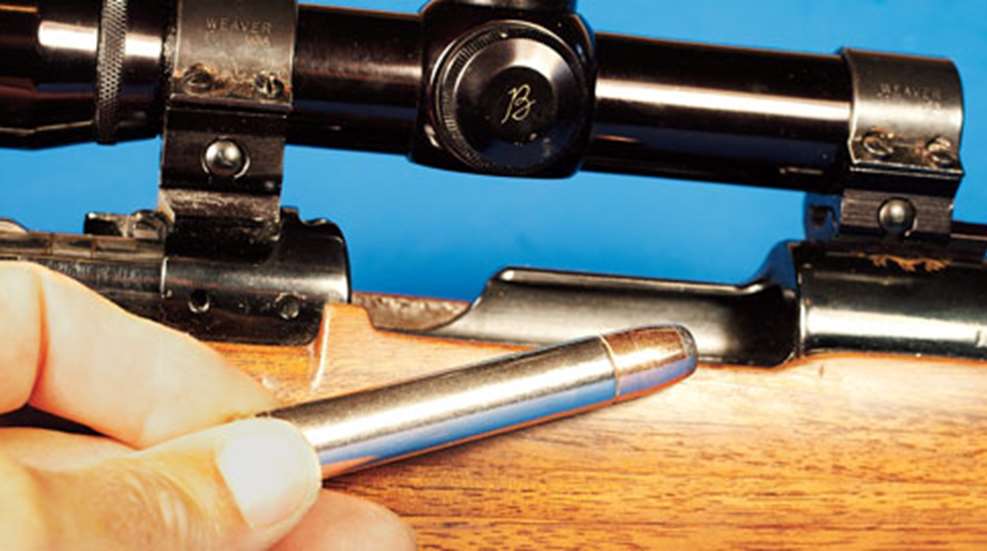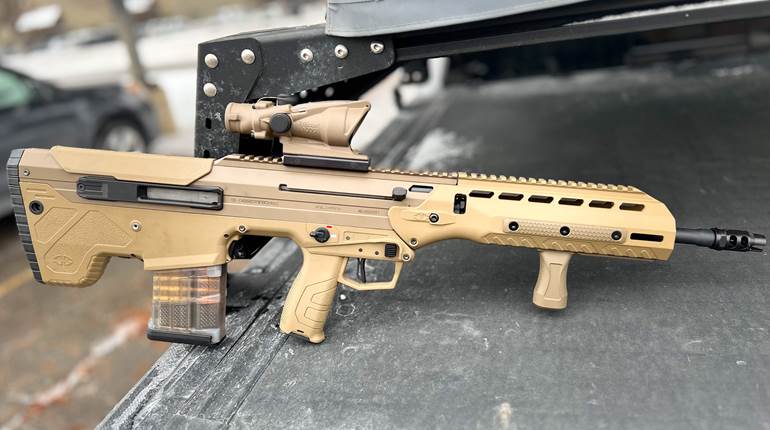
12/26/2012
Does the fear of recoil keep you from shooting an otherwise fine dangerous game rifle? If you’re headed to the tropics or the cold North Country to hunt large game, there’s an obligation to practice with your big-bore rifle. And even if your big rifle has seen its last distant hunt, it can still be serviceable for the back forty deer lot. With some creativity at the handloading bench, loads can be assembled that are easy on the shoulder for practice and hunting domestic big game.
Selecting Soft Loads
I recently shot a few Winchester factory loads with 510-grain bullets from my .458 Win. Mag. A few was more than enough because the recoil of those loads was wicked, even though the rifle weighs nearly 10 pounds. Back home I massaged my jaw in more than just contemplation as I searched through handloading manuals for lighter-recoiling loads that would allow pleasurable practice with the .458 and hunting loads for deer and elk season.
A fellow who sat under an apple tree long ago discovered that for every action there is an equal and opposite reaction. So recoil eases if we load our magnum rifles with less propellant, a lighter bullet, or both. For instance, if 270-grain bullets are your choice for hunting with a .375 H&H Mag., recoil can be reduced somewhat by switching from a maximum load of 80.0 grains to 76.0 grains of H4350. Recoil is softened by nearly a third loading 63.0 graoms of Varget propellant.
The .375’s recoil can also be greatly reduced by simply switching to a lighter bullet, like a Speer 235-grain or Hornady 225-grain bullet. A Hornady 225-grain bullet at a maximum velocity of 2,800 fps yields about 20 percent less kick than a 270-grain bullet at top velocity.
Combine that lighter bullet with a decreased powder charge and recoil becomes as soft as a punch from a pillow. The Speer and Hornady reloading manuals list several such loads for the .375 H&H Mag. For example, a Hornady 225-grain bullet with 36.0 grains of H4227 develops two-thirds less recoil than a full-power load with a 270-grain bullet, or about like the pat of a .243 Win. shooting 100-grain bullets.
For my .458, 500-grain jacketed bullets are unnecessary for practice because paper targets are rather thin-skinned. A 400-grain bullet, such as the Speer soft-point flat-nose, produces somewhat softer recoil. At 2,200 fps that bullet works fine for hunting deer and black bears in the timber. For practice, a slower velocity of 1,255 fps with the 400-grain bullet (which mimics a low-pressure load for the .45-70 Gov’t.) has one-fourth the recoil. I really bore down on the .458 when I shot the three, five-shot groups for each of the two loads for the Speer 400-grain bullet listed in the accompanying table. The groups averaged slightly more than an inch tighter with the lower-velocity loads, which can be attributed to less gritting of my teeth.
An even lighter bullet at a relatively high velocity makes the .458 a good cartridge for big game close to home. The Hornady 350-grain flat- or round-nose bullet starting out at 2,600 fps drops only 8 inches at 250 yards when a .458 is sighted to place the bullets 2 inches above the point of aim at 100 yards. Recoil from that much speed is a bit stiff. Backing down the velocity to 2,300 fps softens kick about 20 percent, yet is still fine for shooting whitetails.
American Rifleman Managing Editor Aaron Carter used a reduced-velocity load in his .416 Rem. Mag. last season to kill a Virginia whitetail. He loaded 29.0 grains of Trail Boss to give Speer 350-grain Mag-Tip bullets a velocity of 1,140 fps. “Very little recoil and deadly on deer,” Carter reported.
Cast lead-alloy bullets are an economical choice. Bullets cast from an RCBS 45-405-FN mold can be loaded in the .458 to duplicate a hotly loaded .45-70 Gov’t, and who has ever questioned its effectiveness on big game? On the light side, 21.0 grains of Hodgdon’s Trail Boss produced a bit more than 1,100 fps with the cast bullet and recoil mild enough to shoot extensively.
A variety of molds and cast bullets are available for big-bore rifles. Forty-five caliber has the widest selection from 300 to 500 grains These bullets are intended mainly for the .45-70, but work fine in the .458. The selection of cast bullets for the .375 is limited to about 250 to 300 grains. A very few cast bullets weighing 350 and 400 grains are options for the .416. If you don’t cast your own bullets, contact Montana Bullet Works.
Picking Propellants
Loading reduced charges of propellant in such large cases allows the possibility of a double charge. Charges of propellants such as IMR-SR4759 and IMR-4227 occupy only a small portion of a .458 case. Shining light from a non-flammable source into the cases after they are charged with such types ensures that propellant is present and is of the correct amount.
IMR Trail Boss is a bulky propellant and nearly fills a .458 case to the base of the bullet. And Accurate 5744 occupies more than half of a .458’s capacity.
Hodgdon Powder’s 60 percent rule is an easy method to develop a reduced-velocity load with powder that fills a majority of a case. The rule is to take the maximum charge of H4895 listed for a cartridge and bullet and multiply that by 60 percent. For instance the Hodgdon handloading manual lists a maximum load of 80.0 grains of H4895 with a 350-grain bullet in the .458. Sixty percent of that is 48.0 grains. That weight of propellant fills more than half a .458 case to guard against a double charge. Recoil is also a gentle 12 ft.-lbs.
I appreciate such gentle shoves when rehearsing for a rifle hunt in the distant north or south or merely walking down to the deer woods.






































